Holistic SEO
Master Semantic Content Clusters: Elevate Your SEO Strategy

Welcome to our comprehensive guide on mastering semantic content clusters and enhancing your SEO strategy significantly. In today’s digital landscape, merely focusing on keywords and website optimization is not enough for achieving top positions in Google searches. Understanding user intent and organizing your content semantically is crucial for successful search engine optimization.
In this article, we will delve into the world of semantic SEO and explore its importance in advanced SEO strategies. From keyword research and content organization to on-page optimization and user intent, we will cover various aspects to help you unlock the full potential of semantic SEO.
Key Takeaways:
- Semantic SEO goes beyond keyword matching and focuses on understanding user intent.
- Organizing your content into semantic clusters improves website visibility and organic traffic.
- Optimizing for semantic SEO leads to higher user engagement and conversions.
- Aligning content with different types of user intent is crucial for semantic SEO success.
- Utilizing structured data markup, LSI keywords, and high-quality content enhances semantic relevance.
The Importance of Semantic SEO in Advanced SEO Strategies
In today’s competitive digital landscape, it is crucial to implement advanced SEO strategies that go beyond traditional keyword optimization. One such strategy that has gained significant importance is semantic SEO. Semantic SEO focuses on understanding user intent and aligning content with relevant topics, ultimately improving website visibility, organic traffic, user engagement, and conversions.
When it comes to advanced SEO strategies, semantic SEO plays a vital role in optimizing websites for search engines. By embracing semantic SEO techniques, website owners can create content that directly addresses user intent and provides comprehensive and relevant information. This ensures that users have a positive experience and find the information they are searching for, leading to increased engagement and conversions.
By incorporating semantic SEO into your SEO strategy, you can improve website visibility and drive more organic traffic. Search engines are constantly evolving and aiming to deliver the most relevant results to users. By optimizing your content with semantic SEO, you can align your website with the search engine’s goals and improve your chances of ranking higher in search results.
Table: Benefits of Semantic SEO
| Benefits | Description |
|---|---|
| Improved Website Visibility | Semantic SEO helps your website get noticed by search engines, leading to higher rankings and increased visibility. |
| Increased Organic Traffic | By optimizing for user intent, you can attract more organic traffic to your website. |
| Enhanced User Engagement | Understanding user intent allows you to create content that resonates with your audience, leading to higher engagement and longer time spent on your website. |
| Higher Conversions | When your content matches user intent, it becomes more persuasive and can lead to higher conversion rates. |
Overall, semantic SEO is an essential component of advanced SEO strategies. By focusing on user intent and aligning your content with relevant topics, you can improve website visibility, attract organic traffic, increase user engagement, and achieve higher conversion rates.
Understanding Semantic Search and User Intent
In today’s digital landscape, search engines have evolved to go beyond simple keyword matching. They now employ sophisticated algorithms that aim to understand the meaning behind search queries and deliver relevant results that satisfy user intent. This approach, known as semantic search, has revolutionized the way we optimize our websites for search engines.
Semantic search focuses on the context and intent behind search queries, rather than just the keywords themselves. It takes into account factors such as synonyms, related concepts, and user behavior to provide the most accurate and relevant results. By understanding user intent, search engines can deliver a better user experience by presenting content that truly answers the user’s query.
For website owners and SEO professionals, it is crucial to align our content with different types of user intent. This means creating content that not only matches the specific keywords but also addresses the underlying questions or problems that users are searching for. By understanding the different types of user intent, we can optimize our content to provide the most relevant and valuable information to our target audience.
The Different Types of User Intent
When it comes to user intent, there are generally four main types:
- Informational Intent: Users are looking for answers, explanations, or information on a specific topic. They want to know “what is,” “how to,” or “why.”
- Navigational Intent: Users are looking for a specific website or webpage. They have a particular destination in mind and want to find it quickly.
- Transactional Intent: Users are looking to make a purchase or engage in a specific action. They are ready to buy, sign up, or subscribe to something.
- Commercial Investigation Intent: Users are researching and comparing products or services before making a decision. They are in the early stages of the buying process and want to gather information.
By understanding the different types of user intent, we can tailor our content to meet the specific needs and expectations of our target audience. This not only improves our chances of ranking higher in search results but also enhances the overall user experience on our website.
| User Intent | Content Approach |
|---|---|
| Informational Intent | Provide comprehensive and informative guides, tutorials, or articles that answer common questions related to the topic. |
| Navigational Intent | Optimize your website structure and navigation to ensure easy access to specific pages or content users are searching for. |
| Transactional Intent | Create clear and compelling product or service descriptions, provide easy-to-use checkout processes, and build trust with testimonials or reviews. |
| Commercial Investigation Intent | Develop in-depth comparison guides, product reviews, or interactive tools to help users make informed decisions. |
Semantic SEO Techniques for Advanced Optimization
In order to master semantic SEO and elevate your website’s optimization, it’s crucial to employ certain techniques that enhance your content’s relevance and visibility. By using structured data markup and leveraging the power of Schema.org, you can provide search engines with additional context about your content, enabling them to better understand and categorize it.
Another essential technique is the utilization of Latent Semantic Indexing (LSI) keywords. These are words and phrases that are semantically related to your main target keywords, helping to expand the semantic relevance of your content. By incorporating LSI keywords naturally into your content, you can improve its overall comprehensiveness and increase its chances of ranking higher in search engine results.
Natural Language Processing (NLP) is another powerful tool to enhance your semantic SEO strategy. By leveraging NLP techniques, you can ensure that your content is optimized for user intent and provides a seamless user experience. NLP allows search engines to understand the meaning and context of your content, enabling them to deliver more accurate and relevant search results.
| Technique | Description |
|---|---|
| Structured Data Markup | Using structured data markup and Schema.org to provide additional context to search engines. |
| Latent Semantic Indexing (LSI) Keywords | Incorporating semantically related keywords to expand the relevance of your content. |
| Natural Language Processing (NLP) | Leveraging NLP techniques to optimize content for user intent and improve user experience. |
| High-Quality Content | Creating content that is informative, engaging, and relevant to your target audience. |
Lastly, the importance of creating high-quality content cannot be overstated. High-quality content that is informative, engaging, and relevant to your target audience plays a crucial role in semantic SEO. It not only attracts and retains visitors but also signals to search engines that your website is a valuable resource. By consistently creating high-quality content, you can enhance your website’s visibility, organic traffic, and overall SEO performance.

In addition to utilizing LSI keywords, leveraging natural language processing techniques can also strengthen the semantic relevance of your content. Natural language processing involves analyzing and understanding the natural language used by humans, allowing search engines to better interpret and rank your content based on its relevance to user intent.
Overall, optimizing your content for semantic SEO involves providing in-depth information, incorporating subtopics, utilizing LSI keywords, and leveraging natural language processing techniques. By implementing these strategies, you can enhance the relevance and depth of your content, ultimately improving the user experience and driving organic traffic to your website.
| Benefits of Optimizing Content for Semantic SEO | Examples |
|---|---|
| Improved relevance and visibility | An article about “healthy eating” that covers subtopics such as “meal planning,” “nutritional benefits,” and “healthy recipes.” |
| Better user experience | A comprehensive guide on “home gardening” that provides in-depth information on topics like “soil preparation,” “planting techniques,” and “pest control.” |
| Higher search engine rankings | A blog post about “digital marketing trends” that incorporates LSI keywords such as “artificial intelligence,” “voice search,” and “content marketing.” |
User Experience (UX) and Semantic SEO
When it comes to optimizing your website for search engines, it’s important to consider the user experience (UX) as a crucial factor. A positive UX not only improves engagement and conversions but also plays a significant role in semantic SEO. Let’s explore some key aspects of UX that can enhance your SEO efforts.
Mobile Responsiveness
In today’s mobile-first world, having a mobile-responsive website is essential. Mobile devices account for a significant portion of organic search traffic, and search engines prioritize mobile-friendly websites in their rankings. Ensuring that your website is fully optimized for mobile devices is not only beneficial for user experience but also for semantic SEO.
Page Speed
Page speed is another critical aspect of UX and semantic SEO. A fast-loading website provides a better user experience and encourages visitors to stay on your site longer. Additionally, search engines like Google consider page speed as a ranking factor. Optimizing your website’s performance by minimizing file sizes, leveraging browser caching, and using content delivery networks (CDNs) can significantly improve page speed and enhance your SEO.
User-Friendly Navigation
A well-structured and intuitive navigation system is key to a positive user experience. Users should be able to easily navigate through your website and find the information they’re looking for without any confusion. By organizing your content into logical categories and using clear menus and navigation links, you can enhance usability and improve your website’s search engine visibility.
On-Page Optimization
On-page optimization is the practice of optimizing individual web pages to rank higher and earn more relevant traffic in search engines. It involves optimizing title tags, meta descriptions, header tags, and image alt text with relevant keywords. Incorporating these elements not only helps search engines understand your content better but also improves the user experience by providing clear and descriptive information.
By focusing on the user experience and implementing these UX strategies, you can create a website that not only pleases your visitors but also aligns with the principles of semantic SEO. Remember, search engines strive to deliver the most relevant and user-friendly results, and by prioritizing UX, you’ll be one step closer to achieving higher rankings and better visibility.

Link Building Strategies for Semantic SEO
Link building is a crucial aspect of semantic SEO, as it helps to establish the relevance and authority of your content. By acquiring contextual and relevant links from authoritative sources, you can enhance the semantic context of your website and improve its visibility in search engine rankings.
To effectively build links for semantic SEO, it is important to optimize anchor text. Anchor text optimization involves using descriptive and keyword-rich anchor text for both internal and external links. This helps search engines understand the context and relevance of the linked content.
When acquiring links, focus on authoritative sources within your industry or niche. These sources should have a strong online presence and a reputation for providing reliable and relevant content. By securing links from such sources, you signal to search engines that your content is trustworthy and valuable.
“Contextual link building is an essential strategy for semantic SEO. By placing your links within the context of relevant and useful content, you not only improve the user experience but also enhance the semantic relevance of your website.” – SEO Expert
Table: Example of Contextual Link Building
| Website | Link Placement | Contextual Relevance |
|---|---|---|
| Industry Blog | Within a blog post discussing a related topic | Highly relevant, provides additional information to readers |
| Online Magazine | As a reference in an article about your industry | Increases credibility and establishes authority |
| Industry Forum | In a discussion thread where your expertise is relevant | Showcases your knowledge and expertise to forum members |
Remember, it’s not just about acquiring links; the content surrounding those links should also be relevant and valuable. Contextual link building goes hand in hand with quality content creation. By focusing on both elements, you can enhance the semantic relevance of your website and improve its overall SEO performance.

Overall, link building is a critical aspect of semantic SEO. By implementing strategies such as contextual link building and anchor text optimization, you can establish your website as a valuable resource within your industry. Additionally, acquiring links from authoritative sources with relevant content will increase the semantic relevance and authority of your website. Remember, the key is to focus on quality over quantity and ensure that all links are placed contextually within relevant and valuable content.
Monitoring and Analyzing Semantic SEO Performance
Monitoring and analyzing the performance of your semantic SEO efforts is crucial for optimizing your website’s visibility and organic traffic. By tracking key metrics and gaining insights into user behavior, you can make data-driven optimization decisions and continually improve your SEO strategy.
One of the essential tools for monitoring your website’s performance is Google Search Console. This free tool provides valuable data on organic traffic, keyword rankings, and click-through rates. By analyzing this data, you can identify the keywords that drive the most traffic to your site and focus your optimization efforts accordingly. Additionally, Google Search Console offers insights into how your website appears in search results and identifies any potential issues that may be affecting your visibility.
Another crucial analytics tool is Google Analytics. This powerful platform provides in-depth insights into user behavior, allowing you to analyze metrics such as bounce rate, time on page, and conversion rates. By understanding how users interact with your website, you can identify areas for improvement and optimize your content and user experience accordingly.
To effectively monitor and analyze your semantic SEO performance, it’s important to establish clear goals and key performance indicators (KPIs) for your website. Determine what metrics are most relevant to your business objectives and regularly track and analyze these metrics to measure your progress and identify areas for optimization. By staying informed about your website’s performance and making data-driven decisions, you can continuously improve your SEO strategy and drive organic traffic to your site.
| Metrics | Description |
|---|---|
| Organic Traffic | Measures the number of visitors coming to your website from organic search results. |
| Keyword Rankings | Tracks the positions of your target keywords in search engine results pages (SERPs). |
| Bounce Rate | Indicates the percentage of visitors who leave your site after viewing only one page. |
| Time on Page | Measures the average amount of time visitors spend on a specific page. |
| Conversion Rates | Tracks the percentage of visitors who complete a desired action, such as making a purchase or filling out a form. |
By regularly monitoring and analyzing these metrics using tools like Google Search Console and Google Analytics, you can gain valuable insights into your website’s performance and optimize your SEO strategy for maximum effectiveness.
Future Trends in Semantic SEO
In the ever-evolving landscape of SEO, it is crucial to stay ahead of the curve and anticipate the future trends that will shape the industry. As we look ahead, three key trends emerge: voice search, conversational AI, and advancements in natural language processing.

One of the most significant developments in recent years is the rise of voice search. With the increasing popularity of virtual assistants like Amazon Alexa and Google Assistant, more and more users are utilizing voice commands to search for information. As a result, optimizing content for voice queries has become essential. Websites that provide direct and concise answers to users’ questions are more likely to be featured as voice search results. This trend highlights the importance of adapting content to conversational search queries and structuring it to match natural language.
Another trend that is shaping the future of semantic SEO is conversational AI. Conversational AI allows machines to understand and respond to human language, making interactions more conversational and natural. This technology enables businesses to provide personalized and interactive experiences to users, improving engagement and satisfaction. From chatbots to virtual assistants, conversational AI has the potential to revolutionize the way users interact with websites, and optimizing content for this technology will be crucial for staying ahead.
Advancements in natural language processing (NLP) are also driving the future of semantic SEO. NLP enables machines to understand and interpret human language, including context, sentiment, and intent. With improved NLP capabilities, search engines can deliver more relevant and accurate results to users. As a result, content creators should focus on creating high-quality, informative, and contextually rich content that aligns with user intent. By leveraging the power of NLP, websites can enhance their visibility and provide a better user experience.
Voice Search, Conversational AI, and NLP: The Future of SEO
- Voice search is on the rise, and optimizing content for voice queries is essential to stay competitive.
- Conversational AI enables businesses to provide personalized and interactive experiences to users, improving engagement and satisfaction.
- Advancements in NLP allow search engines to deliver more relevant and accurate results, emphasizing the need for high-quality, contextually rich content.
The future of semantic SEO lies in adapting to these trends and leveraging their potential to enhance online visibility, user experience, and search engine rankings. By optimizing content for voice search, embracing conversational AI, and capitalizing on advancements in NLP, businesses can stay ahead of their competitors and meet the evolving needs of their target audience. As technology continues to advance, it is vital to stay informed and adapt strategies to ensure continued success in the dynamic world of SEO.
Conclusion
In conclusion, semantic SEO plays a crucial role in elevating our SEO strategy and optimizing our website for maximum visibility and success. By understanding and aligning with user intent, we can create content that not only satisfies search algorithms but also engages and converts users.
One of the key techniques in semantic SEO is the use of topic clusters. By organizing our content into interconnected clusters, we can demonstrate our expertise and authority in a specific subject area, which ultimately boosts our search engine rankings.
Furthermore, website optimization is essential for semantic SEO. By ensuring our website is mobile-responsive, fast-loading, and user-friendly, we can provide a seamless and enjoyable experience for visitors, while also facilitating search engine crawling and indexing.
As the world of SEO continues to evolve, it is important for us to keep adapting and improving our strategies. By staying informed about future trends, such as the rise of voice search and advancements in natural language processing, we can stay ahead of the competition and continue to enhance our semantic SEO efforts.
FAQ
What is semantic SEO?
Semantic SEO is an advanced SEO strategy that goes beyond keyword matching. It focuses on understanding user intent and aligning content with different types of user intent to improve website visibility, organic traffic, and user experience.
Why is semantic SEO important in advanced SEO strategies?
Semantic SEO is important in advanced SEO strategies because it leads to higher engagement metrics, conversions, and better rankings in search engines. By optimizing for semantic SEO, you can provide relevant and comprehensive information that aligns with user intent, improving the overall user experience.
What is semantic search and how is it connected to user intent?
Semantic search is the process through which search engines interpret the meaning behind search queries and deliver results that satisfy user intent. It is connected to user intent because it focuses on understanding what users are looking for and providing them with relevant and useful information.
What techniques can be used to master semantic SEO?
To master semantic SEO, you can use techniques such as structured data markup and schema.org to provide additional context to search engines. You can also leverage Latent Semantic Indexing (LSI) keywords and Natural Language Processing (NLP) techniques to expand the semantic relevance of your content. Creating high-quality and relevant content is also crucial.
How can content be optimized for semantic SEO?
Content can be optimized for semantic SEO by providing in-depth and comprehensive information that addresses various aspects of a user’s query. This can be done by incorporating subtopics, LSI keywords, and natural language processing techniques to improve the relevance and depth of your content. Additionally, ensuring a positive user experience is essential.
What is the relationship between user experience and semantic SEO?
User experience is vital in semantic SEO. It involves optimizing websites for mobile devices, ensuring fast-loading pages, and providing user-friendly navigation. Well-structured websites enhance user experience and facilitate search engine crawling and indexing. On-page optimization techniques, such as optimizing title tags, meta descriptions, header tags, and image alt text, also contribute to improved user experience.
What are effective link building strategies for semantic SEO?
Effective link building strategies for semantic SEO include acquiring links from authoritative and relevant sources that align with the semantic context of your content. It’s important to place contextual and relevant links within your content to enhance relevance and authority. Additionally, optimizing anchor text for both internal and external links can further improve semantic SEO.
How can the performance of semantic SEO be monitored and analyzed?
The performance of semantic SEO can be monitored and analyzed by tracking organic traffic trends, keyword rankings, and user behavior. Tools like Google Search Console and Google Analytics provide insights into website performance, allowing you to make data-driven optimization decisions.
What are the future trends in semantic SEO?
The future of semantic SEO is influenced by voice search and conversational AI. Optimizing content for voice queries and providing direct, concise answers will become increasingly important. Advancements in natural language processing will also impact search engine understanding and relevance.
What is the importance of semantic SEO in enhancing SEO strategies?
Semantic SEO plays a crucial role in enhancing SEO strategies by focusing on topic clusters, user intent, and website optimization. By aligning content with user intent, optimizing for semantic SEO can improve online visibility and success in search engine rankings.
Holistic SEO
DIY SEO Audit: A Step-by-Step Guide for Non-Technical Users
Improve your website’s performance with our DIY SEO audit guide, and uncover essential strategies that will transform your online presence. Discover more inside!

A DIY SEO audit helps you boost your website's performance without needing technical skills. Start by setting clear goals and gathering data using tools like Google Analytics and Screaming Frog. Next, conduct your audit by checking technical aspects like site speed and mobile-friendliness while optimizing on-page elements like title tags and meta descriptions. Analyze your findings by categorizing issues and prioritizing fixes based on their impact. Finally, implement improvements and monitor your site regularly for a smoother user experience. With these steps, you'll pave the way for better visibility, and there's even more to discover along the way.
Key Takeaways
- Start by defining SMART goals for your SEO audit to clarify what you want to achieve.
- Use user-friendly tools like Google Analytics and Screaming Frog to gather relevant performance data.
- Conduct a site crawl to identify technical issues such as broken links and slow loading times.
- Optimize on-page elements like title tags and meta descriptions for better search visibility.
- Document your findings and create a strategic roadmap for implementing necessary improvements.
Understanding SEO Audits
When you immerse yourself in the world of SEO, understanding SEO audits is essential for your website's success. An SEO audit is a thorough evaluation that looks at your website's performance, visibility, and content quality. By conducting an audit, you'll identify technical issues, on-page errors, and off-page shortcomings that could hinder your search engine rankings.
Regular audits are particularly important as AI advancements raise significant privacy concerns regarding user data management and how it impacts your site's compliance with search engine policies.
Search engines assess your site based on its technical setup and the relevance of your content. This means regular audits are vital to keep your website optimized and adaptable to algorithm changes. It's recommended to perform basic checks quarterly and conduct more detailed evaluations at least once a year. If you make significant changes to your site, consider running an additional audit.
An effective SEO audit acts as a diagnostic tool, revealing strengths and weaknesses in your online presence. With this information, you can create a clear action roadmap to enhance your website visibility and improve organic traffic.
Preparing for Your Audit

Preparing for your SEO audit involves setting clear goals and gathering essential data to confirm an efficient evaluation. Start by defining SMART goals that focus your efforts and outcomes. This will help you stay on track throughout the audit process.
Familiarize yourself with SEO audit tools like Google Analytics to analyze audience behavior and Screaming Frog to identify broken links and metadata issues. Additionally, understanding how dog health and nutrition can impact your site's engagement might provide insights into creating relevant content.
Next, gather the necessary data, including traffic statistics, keyword rankings, and existing site performance metrics. This information provides a solid foundation for your analysis. Create a detailed checklist tailored to your website's structure and content. Verify it covers key areas like technical SEO, on-page optimization, and user experience factors.
Don't overlook the importance of adhering to search engine guidelines. Focus on essential aspects such as mobile-friendliness and page load speed, as these greatly impact overall performance.
Conducting the Audit

To kick off your SEO audit, start by defining clear objectives that will guide your assessment process effectively. Whether you aim to improve website traffic or enhance user experience, having specific goals in mind is essential.
Additionally, implementing keyword clustering and topic clustering can provide a structured approach to understanding which content areas to focus on. Next, utilize free tools like Google Search Console and Google Analytics to gather vital data on site performance, such as organic traffic patterns and indexing status.
Conduct a site crawl using tools like Screaming Frog SEO Spider to identify any technical issues that may hinder your SEO performance. Look for broken links, missing meta tags, and duplicate content.
After addressing these issues, focus on analyzing on-page elements. Optimize your title tags (50-60 characters) and meta descriptions (155-160 characters) for better visibility in search results, while ensuring proper use of header tags to improve content structure.
Analyzing Findings

Analyzing your findings from the SEO audit is essential for pinpointing specific areas that need improvement. Start by categorizing the issues you've identified into technical, on-page, and off-page SEO. This approach helps you focus on the most critical areas. Use tools like Google Analytics and Google Search Console to assess traffic patterns and user engagement metrics, allowing you to understand user behavior on your site.
Here's a quick table to help you organize your findings:
| Issue Type | Actionable Steps |
|---|---|
| Technical SEO | Fix broken links, improve site performance |
| On-page SEO | Optimize content for high-impact keywords |
| Off-page SEO | Enhance backlink strategy |
| User Experience | Improve site navigation and load times |
| User Engagement | Monitor bounce rates and adjust content accordingly |
Prioritize the issues based on their potential impact on rankings and user experience. Focus first on critical technical issues like broken links or slow loading times. Document everything clearly to create a strategic roadmap outlining actionable steps, responsible parties, and timelines for implementing necessary changes.
Implementing Improvements

Implementing improvements based on your SEO audit findings is crucial for boosting your website's performance and visibility. Start by optimizing your site speed; use tools like Google PageSpeed Insights to guarantee your pages load in under 5 seconds. This enhances user experience and can greatly improve your search rankings.
Additionally, incorporating elements that deter potential issues is critical, as seen with the value of home security systems, which highlight the importance of preventative measures.
Next, review your on-page elements. Make certain your title tags are 50-60 characters and meta descriptions are between 155-160 characters. These tweaks can increase your click-through rates and draw more visitors to your site.
Don't forget to monitor for broken links. Regularly check your site for 404 errors, as they can frustrate users and lead to lost traffic. Tools like Screaming Frog can help you identify these broken links efficiently.
Conclusion
Now that you've bravely ventured into the wild world of DIY SEO audits, you might feel like a digital superhero, cape flapping in the virtual wind. You've analyzed, scrutinized, and strategized like a pro! But remember, even superheroes need sidekicks—don't hesitate to call in the experts when the SEO villains get too tricky. So, take a breather, sip that overpriced coffee, and let your website shine brighter than a disco ball at a 70s party!
Chris, SEO and Keywords Expert & Author: Chris lives and breathes SEO. With a deep understanding of keyword research and strategy, he’s our go-to guru for everything related to search rankings. Chris has a knack for identifying trends and opportunities in the SEO world, making him an invaluable asset to our team and our clients.
Holistic SEO
Mastering SEMrush: Unlocking the Full Potential of Your SEO Toolkit
Just when you think you know SEMrush, discover game-changing strategies that can transform your SEO efforts and unlock untapped potential.
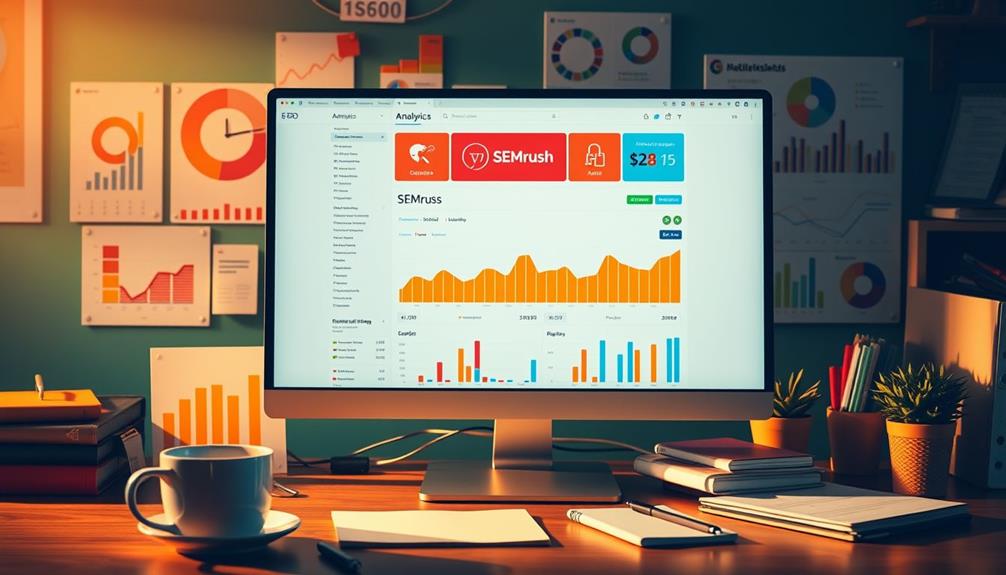
Mastering SEMrush can elevate your SEO game considerably. With over 40 tools at your fingertips, you can conduct thorough website audits using the Site Audit Tool to fix technical issues. Leverage the Keyword Magic Tool to find high-traffic, low-competition keywords, and use the Content Marketing Tool for real-time optimization. Analyze your competitors' strategies with the Organic Research and Traffic Analysis tools to identify new opportunities. Regular monitoring of performance metrics helps you stay adaptable. Discovering these strategies can truly reveal SEMrush's potential for your digital marketing efforts. Keep exploring, and you'll uncover even more valuable insights.
Key Takeaways
- Utilize the Keyword Magic Tool for in-depth keyword analysis to identify high-traffic, low-competition opportunities for your SEO strategy.
- Conduct regular website audits with the Site Audit Tool to identify and prioritize technical issues affecting site health and SEO performance.
- Leverage the Content Marketing Tool's SEO Writing Assistant to optimize content in real-time for keyword usage and readability improvements.
- Analyze competitors using the Organic Research and Traffic Analysis tools to uncover their top-performing keywords and ad strategies for informed decision-making.
- Monitor performance metrics with customizable reporting tools to track KPIs like organic traffic and keyword rankings, ensuring continuous optimization.
Overview of SEMrush Tools
SEMrush is like a Swiss Army knife for digital marketers, offering a wide array of tools that streamline various aspects of online strategy. With over 40 SEO tools at your fingertips, you can enhance your PPC, content marketing, and social media efforts seamlessly.
Additionally, effective email marketing strategies can complement your SEO efforts by driving targeted traffic to your site. One standout feature is the Keyword Magic Tool, which helps you discover effective keywords by analyzing search volumes and competition levels. This empowers you to make strategic keyword selections that drive traffic.
The Site Audit tool is another gem, evaluating your website against over 130 technical and SEO checks. It identifies issues that could hinder your site's health and ranking, providing actionable insights to help you improve.
Coupled with its technical SEO capabilities, this feature guarantees your site performs at its best.
Don't overlook the Content Marketing Tool, which includes an SEO Writing Assistant offering real-time feedback to refine your content for search engines.
Plus, you can customize your dashboards to track key metrics like organic traffic and keyword rankings, allowing for focused competitive analysis.
With SEMrush, you're equipped to take your SEO strategies to the next level.
Conducting Website Audits

Conducting regular website audits is essential for maintaining your site's health and guaranteeing ideal SEO performance. By utilizing the Site Audit feature within SEMrush, you can conduct thorough assessments that check for over 130 technical issues that may impact your rankings.
These audits help you identify critical areas like crawl errors, HTTPS implementation, and site speed—key factors in guaranteeing optimal website health and a positive user experience. Additionally, having a methodical approach to these audits mirrors the importance of quality assurance in software development, guaranteeing that your website not only meets industry standards but also provides a reliable experience for users.
After running an audit, SEMrush generates actionable recommendations tailored to your specific needs, allowing you to prioritize issues based on their potential impact on your SEO strategies. Customizing your audit reports enables you to focus on particular aspects of your website, making it easier to track improvements over time.
To stay competitive in search engine rankings, schedule periodic audits—ideally quarterly or after significant site changes. This proactive approach guarantees that you remain ahead of new issues and maintain the effectiveness of your SEO efforts.
Effective Keyword Research

Revealing the potential of effective keyword research can greatly enhance your SEO strategy and drive organic traffic to your site.
With SEMrush's Keyword Magic Tool, you can discover over 5 million keywords, allowing you to pinpoint high-traffic, low-competition options. Start by analyzing keyword difficulty scores, which range from 0 to 100. This helps you prioritize less competitive keywords that boost your chances of ranking higher in search results.
Additionally, implementing keyword clustering can further refine your strategy by organizing related keywords into cohesive topics.
Next, assess the search volume for potential keywords. Higher search volume often correlates with increased visibility and organic traffic when optimized correctly.
Don't forget to utilize the Organic Research tool to analyze your competitors. By evaluating the keywords they rank for, you can uncover opportunities to enhance your own keyword targeting.
Developing Content Strategies

Crafting a solid content strategy is vital for maximizing your SEO efforts and engaging your audience effectively. Start by utilizing the Topic Research tool in SEMrush to generate content ideas based on current trends and audience interests. This helps you create relevant, engaging material that resonates with users.
Additionally, consider incorporating goal tracking tips to refine your content strategy and guarantee that you stay aligned with your overall objectives.
Next, leverage the SEO Writing Assistant to optimize your content in real-time. It'll suggest improvements for keyword usage, readability, and tone, assuring your writing aligns with SEO best practices.
Conduct a thorough Content Audit to evaluate existing content performance. This identifies opportunities for updates or enhancements to boost search rankings and user engagement.
Monitoring keyword performance with the Position Tracking tool is essential. It allows you to adjust your content strategies based on how well your targeted keywords are ranking over time.
Finally, implement strategic keyword selection by using the Keyword Magic Tool to discover high-traffic keywords, focusing particularly on long-tail keywords for better ranking opportunities and precise audience targeting.
Analyzing Competitors
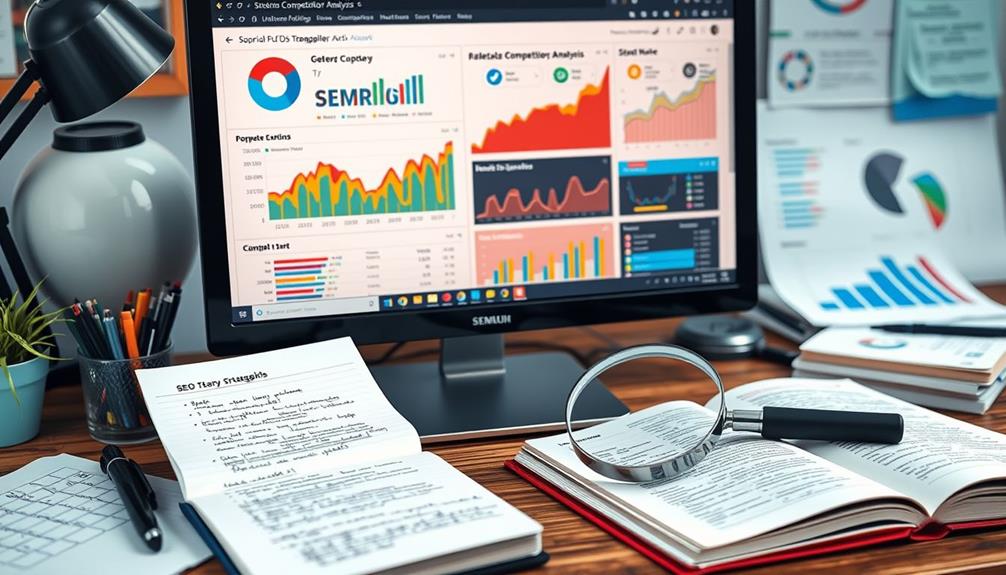
Understanding your competitors is a key part of refining your SEO strategy after developing your content plan. With SEMrush, you can gain valuable insights into your rivals, allowing you to adjust your approach effectively.
A thorough lifestyle approach can also enhance your digital marketing efforts, similar to how holistic lifestyle approach can alleviate menopause symptoms.
Here are some powerful tools to utilize:
- Organic Research tool: Uncover competitors' top-performing keywords, estimated traffic, and their search engine positioning, revealing opportunities for your own strategy.
- Traffic Analysis feature: Get insights into competitors' ad strategies and spending, helping you understand their overall digital marketing approach.
- Backlink Analysis: Evaluate your competitors' backlink profiles to identify high-quality referral sites that can benefit your link-building efforts.
- Position Tracking tool: Regularly monitor competitors' keyword rankings, enabling you to benchmark your performance and adapt your tactics in real-time.
PPC Management Techniques
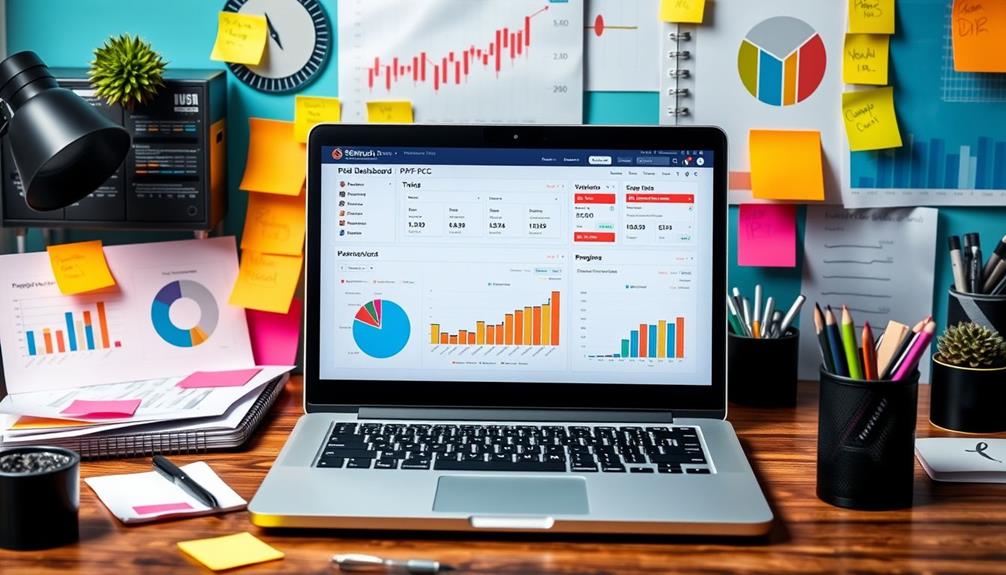
While effective PPC management can greatly boost your online visibility, mastering the right techniques is essential for maximizing your return on investment. Start by utilizing the Keyword Magic Tool within Semrush to discover profitable PPC keywords. You'll gain insights into search volumes and competition levels, allowing you to target campaigns more effectively.
Additionally, consider the value of budget-friendly vacuum cleaners that can enhance your cleaning routine while saving money.
Next, take advantage of the Ad Builder to streamline your ad creation process. This tool offers customizable templates that align with best practices, ensuring higher click-through rates.
Don't forget the importance of Traffic Analysis; by examining competitor ad strategies, you can assess their estimated ad spend and performance metrics, providing you with valuable insights to refine your own approach.
Regularly track your performance metrics to analyze ROI and campaign effectiveness. Adjust your bidding strategies based on real-time data to optimize results.
Finally, use the Position Tracking tool to monitor keyword rankings over time. This will help you adapt your campaigns to changes in search behavior and competition dynamics, ensuring your PPC efforts remain strong and relevant.
Reporting and Analytics

When it comes to measuring the success of your SEO efforts, having robust reporting and analytics tools is essential. SEMrush provides you with powerful customizable reporting features that integrate seamlessly with Google Analytics, giving you an extensive view of your campaign's performance data.
In today's competitive landscape, understanding the nuances of cybersecurity measures is vital for protecting your digital assets and ensuring your SEO strategies aren't undermined by vulnerabilities.
With SEMrush, you can benefit from:
- Scheduled Reports: Automate report deliveries to stakeholders for consistent communication.
- Data Visualization: Utilize visual tools to easily identify trends and make informed decisions.
- Brand Monitoring: Track online mentions and sentiment to gain insights into your brand's performance.
- Consolidated Dashboard: Access key performance metrics at a glance for quick monitoring.
Continuous Optimization Strategies

To keep your SEO efforts sharp, regularly conduct Site Audits with SEMrush's Site Audit feature to pinpoint issues that could hinder performance.
This is similar to how testimonials enhance credibility in leadership, as it helps in establishing trust with your audience.
By monitoring performance metrics, you can make real-time adjustments that align with user behavior and traffic sources.
This proactive approach guarantees your strategies stay effective and responsive to changing conditions.
Regular Site Audits
Regular site audits are essential for maintaining and enhancing your website's SEO performance, as they uncover critical technical issues that could hinder your success.
By utilizing SEMrush for regular site audits, you can identify over 130 technical and SEO issues, allowing you to prioritize fixes that improve your website health and performance. Incorporating tools and techniques from music production basics can also enhance your approach to website optimization.
Conducting these audits at least quarterly helps you track improvements and discover new issues, ensuring continuous optimization of your SEO strategy.
Here's what you can gain from regular site audits:
- Actionable recommendations based on your audit findings to enhance site speed and overall user experience.
- Customizable audit reports that allow you to focus on critical areas of concern.
- Insights into crawl errors and HTTPS implementation to maintain a user-friendly site structure.
- Continuous monitoring of your website's technical health, ensuring it remains favorable for search engine crawlers.
Performance Metrics Monitoring
Monitoring performance metrics is essential for ensuring your SEO strategies are effective and continuously optimized. By leveraging SEMrush's customizable reporting tools, you can track key performance indicators (KPIs) such as organic traffic, keyword rankings, and backlinks. This gives you an extensive view of your SEO effectiveness.
Understanding the importance of background checks before job offers, for instance, can parallel how you assess your SEO metrics to mitigate risks in your online presence, particularly regarding compliance and credibility in your industry importance of background checks.
Utilize the Position Tracking tool to monitor daily changes in keyword rankings. This enables you to make timely adjustments to your strategies based on performance data.
Conduct periodic Site Audits to identify and rectify over 130 technical issues that may hinder site performance, improving your overall SEO health and user experience.
Integrating Google Analytics with SEMrush offers deeper insights into user behavior and traffic sources, paving the way for data-driven decisions that enhance your optimization strategies.
Don't overlook the Content Audit feature, which evaluates existing content against current SEO practices, ensuring that your website stays relevant and competitive in search engine results.
Conclusion
In summary, mastering SEMrush isn't just a game changer; it's like discovering a secret treasure map for your online success! With these powerful tools at your fingertips, you're not just optimizing your site—you're launching a digital rocket ship straight to the top of search results! So immerse yourself, explore every feature, and watch your traffic soar like never before. The SEO universe is yours to conquer, and SEMrush is your ultimate sidekick!
Chris, SEO and Keywords Expert & Author: Chris lives and breathes SEO. With a deep understanding of keyword research and strategy, he’s our go-to guru for everything related to search rankings. Chris has a knack for identifying trends and opportunities in the SEO world, making him an invaluable asset to our team and our clients.
Holistic SEO
Demystifying Google Search Console: A Comprehensive Guide
Discover how to leverage Google Search Console for your website’s success and unlock essential strategies that could transform your online presence.

Google Search Console is your go-to tool for boosting your website's visibility in search results. It gives you essential metrics like clicks, impressions, and click-through rates, helping you understand user engagement. You can monitor indexing statuses with the URL Inspection Tool and submit sitemaps for better crawl efficiency. Furthermore, you can improve user experience and SEO by optimizing your site's performance. With GSC's insights, you can track keyword performance and enhance content quality. As you explore its features, you'll uncover strategies that can greatly elevate your site's success online. There's a lot more to discover!
Key Takeaways
- Google Search Console (GSC) enhances website visibility by providing essential metrics like clicks, impressions, and CTR for effective traffic analysis.
- The Performance Report and Page Indexing Report help monitor site performance and indexing status, ensuring important pages are discoverable.
- User experience factors, such as mobile-friendliness and site security, significantly impact SEO rankings, as evaluated through Core Web Essentials metrics.
- Utilizing tools like the URL Inspection Tool and Sitemaps Report facilitates efficient indexing and crawling of websites, optimizing search engine performance.
- Regular analysis of keyword performance and content quality through GSC informs strategic adjustments to improve user engagement and search visibility.
Overview of Google Search Console
Google Search Console (GSC) is an invaluable tool for anyone looking to enhance their website's presence in search results. This free platform helps you monitor and optimize your site's performance in Google search, offering essential insights into your websites that are critical for effective SEO.
With GSC, you can track fundamental metrics like clicks, impressions, click-through rates (CTR), and average position, allowing you to assess your search visibility accurately. Utilizing tools like email marketing software selection can complement your SEO efforts by making certain your content reaches the right audience.
One of the standout features is the URL Inspection Tool, which helps you check the indexing status of your pages and identify any visibility issues. By diagnosing crawl errors, you can quickly resolve technical problems that might hinder your site's performance in Google search.
Additionally, GSC monitors site security, alerting you to potential hacking attempts or vulnerabilities, which is key for maintaining your website's integrity.
The Performance Report in GSC provides a thorough overview of how Google interacts with your site, empowering you to make informed decisions for optimization. By leveraging these features, you can greatly enhance your site's SEO and guarantee it ranks better in search results.
Performance and Indexing Reports

When diving into the Performance and Indexing Reports in Google Search Console, you'll uncover essential data that can greatly impact your SEO strategy.
The Performance Report provides key metrics like clicks, impressions, and Click-Through Rate (CTR), enabling effective traffic analysis. Understanding how these elements work together is fundamental for optimizing your site, similar to how protecting your savings is significant when considering investments.
Here are some important aspects to focus on:
- Clicks: The number of times users visit your site from search results.
- Impressions: Counted each time your URL appears in search results.
- CTR: Calculated by dividing clicks by impressions, showing how effective your titles and descriptions are.
- Page Indexing Report: Categorizes your pages into indexed, crawled but not indexed, and excluded statuses.
URL and Sitemap Management Tools
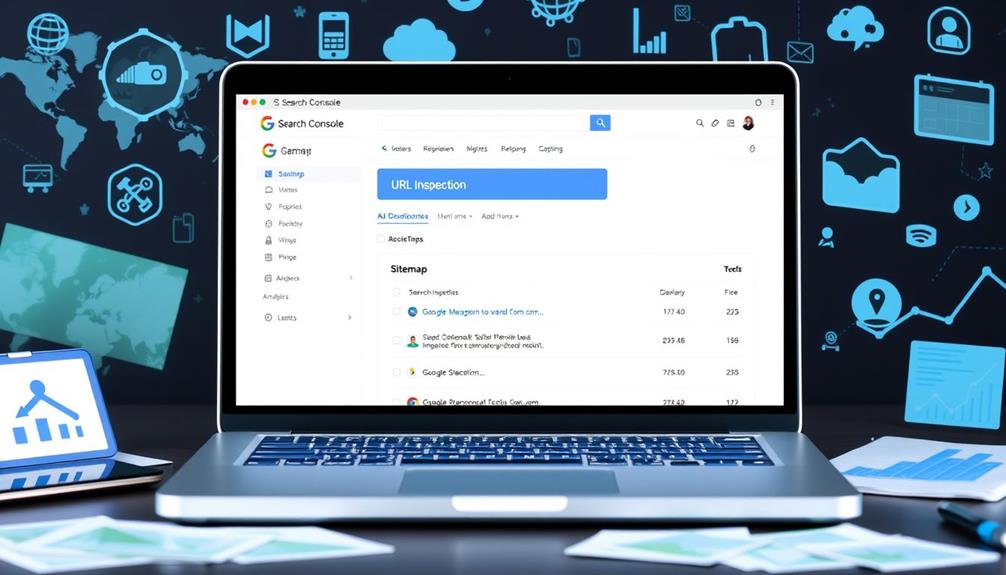
Managing your URLs and sitemaps effectively is vital for optimizing the visibility of your website. Google Search Console offers powerful tools, like the URL Inspection Tool, that provide detailed insights into the indexing status of your individual URLs. You can check the last crawl date and mobile usability metrics, helping you troubleshoot any potential issues.
Additionally, utilizing keyword clustering can enhance the discoverability of your content, making it easier for search engines to index your pages.
When you submit sitemaps through Google Search Console, you help Google discover and index important pages on your site. The Sitemaps Report shows the number of discovered URLs and the status of your submitted sitemaps, allowing you to identify any indexing problems. This way, you can make sure that all notable content is crawled efficiently.
If you've updated content or added new pages, you can utilize the URL Inspection Tool to request indexing. This places your URLs in a priority crawl queue, although immediate indexing isn't guaranteed.
Regularly monitoring the Sitemaps section is essential for evaluating how well Google interacts with your sitemap, making sure all vital pages are included, and revealing discrepancies between expected and discovered URLs. Effective sitemap management can greatly enhance your site's performance in search results.
User Experience and SEO Impact

While many factors influence your site's SEO performance, user experience (UX) has emerged as a crucial element. When you prioritize UX, you directly impact your SEO rankings.
Google evaluates sites based on user experience signals, such as mobile-friendliness and site security, which is essential for maintaining user trust and engagement in today's digital landscape. The importance of value of home security systems in ensuring a safe online environment parallels the need for a secure and accessible website.
To enhance your site's performance, focus on these Core Web Essentials metrics:
- Largest Contentful Paint (LCP): Measures loading performance.
- First Input Delay (FID): Evaluates interactivity.
- Cumulative Layout Shift (CLS): Assesses visual stability.
A positive user experience can lead to improved engagement metrics. Lower bounce rates and increased time on site signal to Google that your content is beneficial, boosting your organic traffic.
The Page Experience Report in Google Search Console is a beneficial tool that helps you assess how well your site meets these UX criteria. By addressing any shortcomings, you can enhance user satisfaction and, consequently, your SEO performance.
Importance of SEO Tools
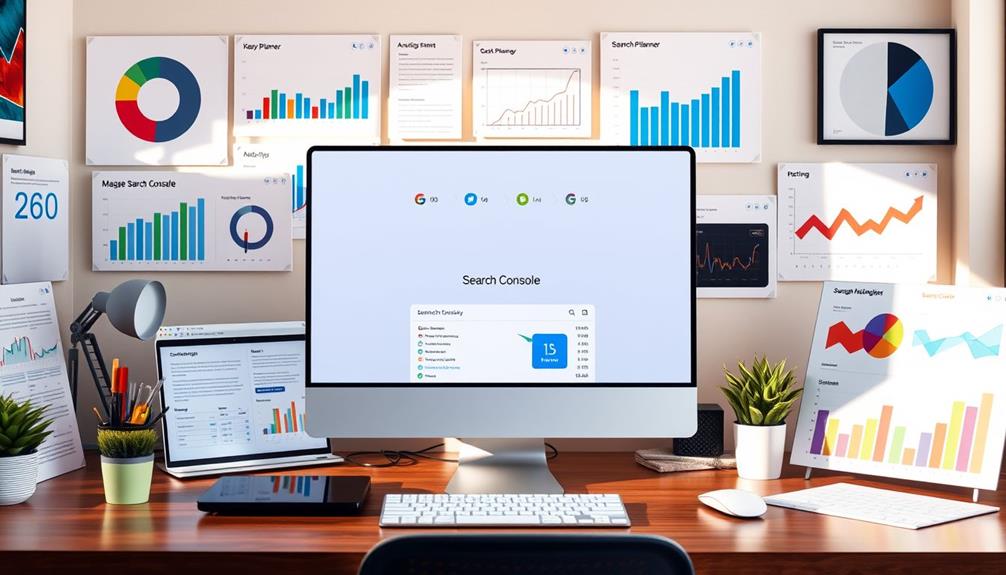
SEO tools are indispensable for anyone serious about improving their website's performance. Tools like Google Search Console offer essential insights into performance metrics, including clicks, impressions, and click-through rates (CTR). These metrics are essential for boosting your search visibility and guaranteeing that your content reaches the right audience.
Additionally, the integration of AI advancements can enhance your understanding of AI applications in various industries, allowing you to identify trends and optimize your strategies effectively.
By utilizing SEO tools, you can identify and resolve indexing issues that may hinder your site's ability to be crawled and ranked effectively by search engines. This guarantees that your web pages are accessible, which is critical for driving traffic to your site.
Furthermore, the data from these tools can guide your content optimization efforts. You'll discover high-performing keywords and search queries that can improve your content strategy.
Regular monitoring through SEO tools allows you to track the impact of your SEO efforts, making it easier to adapt your strategies based on performance trends and user behavior.
In addition, effective use of these tools can greatly enhance the user experience by evaluating mobile usability and page speed—factors that are increasingly important for both search engine rankings and user engagement.
Optimization Strategies and Benefits

When you use Google Search Console, you can effectively track keyword performance and enhance your content quality.
Implementing a methodical approach to your site structure can greatly improve indexing, ensuring that search engines can easily find and rank your pages. These strategies not only boost your visibility but also improve user engagement, leading to better overall results.
Tracking Keyword Performance
Tracking keyword performance is essential for maximizing your website's visibility and driving organic traffic. Google Search Console (GSC) offers a detailed Performance Report that lets you monitor key metrics like clicks, impressions, and click-through rate (CTR) for specific search queries.
By diving into Search Analytics data, you can uncover high-performing keywords and optimize your content to capture even more organic traffic. A methodical approach to analyzing data is fundamental, and understanding software development lifecycle principles can enhance your overall digital strategy best practices in software quality assurance.
Here are some strategies to enhance your keyword performance tracking:
- Analyze clicks and impressions to understand which keywords are driving traffic.
- Evaluate click-through rates to identify keywords needing content adjustments.
- Monitor trends over time to refine your SEO strategies based on seasonal or market changes.
- Make timely content updates to maintain or improve rankings as search behavior shifts.
Regularly using GSC to track keyword performance helps you stay ahead of the curve, ensuring your content remains relevant and engaging.
This proactive approach is essential for enhancing your site's visibility in search results and maximizing your return on investment in SEO efforts.
Enhancing Content Quality
To improve your website's visibility and user engagement, focusing on content quality is essential. Using Google Search Console (GSC) provides valuable insights for content creators looking to enhance their work. By analyzing the Performance Report, you can discover your average position in search results, guiding you in optimizing existing pages.
Here's a quick overview of the strategies:
| Strategy | Benefit | Tool Used |
|---|---|---|
| Optimize meta titles | Boost click-through rates | GSC Performance Report |
| Enhance content relevance | Align with user intent | GSC Impressions |
| Monitor indexed pages | guarantee content visibility | URL Inspection Tool |
| Adjust based on CTR | Improve underperforming pages | GSC Click-Through Rates |
Improving Site Indexing
Improving site indexing is essential for ensuring that your content reaches its intended audience effectively. By optimizing your site for indexing, you enhance its visibility in search results, which can greatly boost your SEO performance.
Additionally, leveraging the right WordPress features can streamline your content management and improve indexing outcomes. Here's how you can achieve better indexing:
- Submit an XML sitemap: This helps Google crawl and index all important pages on your site efficiently.
- Check the Page Indexing Report: Regularly review this report to identify any non-indexed pages, allowing you to tackle issues that might hinder your site's performance.
- Use the URL Inspection Tool: This tool lets you manually request indexing for updated or new pages, speeding up their appearance in search results.
- Monitor the Coverage report: Address any errors or warnings that could impact your indexing status, enhancing your site's overall visibility.
Conclusion
To sum up, Google Search Console is like a compass guiding you through the vast landscape of SEO. By leveraging its powerful tools and insights, you can enhance your site's performance, improve user experience, and boost your visibility. Don't underestimate the importance of these resources—embracing them can lead to significant growth for your online presence. So, plunge into, explore its features, and watch your website flourish in the search results!
Chris, SEO and Keywords Expert & Author: Chris lives and breathes SEO. With a deep understanding of keyword research and strategy, he’s our go-to guru for everything related to search rankings. Chris has a knack for identifying trends and opportunities in the SEO world, making him an invaluable asset to our team and our clients.
-

 Holistic SEO3 months ago
Holistic SEO3 months agoHolistic Local SEO Tactics for Small Businesses
-

 Holistic SEO3 months ago
Holistic SEO3 months agoHow to Establish Dominance in SEO through Topical Authority
-

 Holistic SEO3 months ago
Holistic SEO3 months agoKeyword Research (SEO) for Tattoo Artists
-

 Learning Center3 months ago
Learning Center3 months ago52 Niches with Good Crossover Potential Explored
-

 Learning Center3 months ago
Learning Center3 months agoThe Future of SEO: Leveraging the Google Search Generative Experience
-

 Holistic SEO3 months ago
Holistic SEO3 months agoHolistic SEO Food Blogger
-

 Keyword Research3 months ago
Keyword Research3 months agoMastering SEO: How to Analyze Keyword Results and Find Easy Keywords
-

 Technical SEO3 months ago
Technical SEO3 months agoUnlock Your Site’s Potential with a Comprehensive Website Audit




















